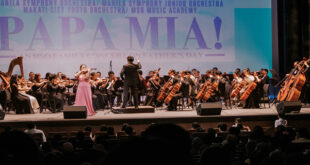
Baguio is a city and hill station located at an altitude of 1450 meters above sea level (4760 feet) on the Cordillera Administrative Region in the middle of the island of Luzon, in the Philippines. Due to its cool mountain weather, Baguio is considered the summer capital of the Philippines. Because of its many pine trees it is also called the City of Pines. Baguio City, is a highly urbanized city in northern Luzon of the Philippines, now also known as Summer Capital of the Philippines. It is geographically located within Benguet, serving as the provincial capital from 1901 to 1916, but has since been administered independently from the province following its conversion into a chartered city. The city has become the center of business, commerce, and education in northern Luzon, as well as the regional center of the Cordillera Administrative Region. According to the 2015 census, Baguio has a population of 345,366. Baguio was established as a hill station by the Americans in 1900 at the site of an Ibaloi village known as Kafagway. It was the United States’ only hill station in Asia. The name of the city is derived from bagiw, the Ibaloi word for “moss”. The city is situated at an altitude of approximately 1,540 meters (5,050 feet) in the Luzon tropical pine forests ecoregion conducive for the growth of mossy plants and orchids. To get to Baguio from outside of Luzon, one would still need to pass through Manila or Clark airport and from there get to Baguio by either of the following ways: By bus: From Manila: This is the most common and economical way to get to Baguio Cityfrom Metro Manila. Several bus lines ply the Metro Manila to Baguio route with terminals scattered across the metro. It generally takes about 4-6 hrs to get to Baguio by bus, longer than it would by car due to stops along the way. Victory Liner, ☎ +63 2 727 4534, +63 2 833 5019 to 20, [2]. has hourly bus service to Baguio from its Monumento Main terminal in Caloocan City, Cubao and Pasay terminals. Buses are generally modern and air-conditioned but seats are sized generally for Filipinos and tall people would need to take advantage of the various stopovers to stretch their legs. Cost is just ₱455 per person one way (Most expensive among Aircon buses going to Baguio). A non-stop deluxe bus service is also available for 750 Pesos per person one way, water and snack are served during the trip. Semi-Deluxe buses are now included with one stop at Tarlac Shell station, costs around 650 pesos, no toilet inside the Bus. By plane: Sky Pasada no longer lists Baguio as a destination. Only private planes land at Loakan Airport in Baguio. Sky Pasada stopped the flights on November 2011, but have not yet updated their website which states that they do fly to Baguio. Clark Airport is a 5hr bus ride to Baguio City, take a shuttle from the airport to Dau Bus Terminal, then a bus to Baguio. Clark Airport receives flights from other parts of East and Southeast Asia. The Ninoy International Airport in Manila is a 6hr bus ride to Baguio, take a taxi from the airport to the Victory Liner Bus Terminal in Pasay, then take a bus to Baguio. By car: From Manila to Baguio by car, take the North Luzon Expressway (NLEX) from Quezon City until Clark and then hop on to the new Subic-Clark-Tarlac Expressway (SCTEX) all the way north to Tarlac City, Tarlac. From there, it’s back to the old McArthur Highway until Rosario Junction, La Union. Motorists drive through the provinces of Bulacan, Pampanga, Tarlac and Pangasinan and La Union (if via Marcos Highway) or Benguet (if via Kennon Road). [Note: TPLEX is now open; you can take it from SCTEX to avoid much of McArthur Highway] Of the three main routes leading up to Baguio, scenic Kennon Road is the shortest route, only three-quarters to one hour from the foot of the mountains in Rosario, Pangasinan. Kennon Road is sometimes closed during the rainy season from June to October because of the danger of landslides. Buses and heavy vehicles are banned from Kennon, the route is only open for light vehicles. Marcos Highway starts in Pugo, La Union (a little further to the northwest from Rosario) and takes about one hour but is a wider, less winding road with a more gradual uphill incline and is safer in the rainy season. It has spectacular vistas of the South China Sea on a clear day. Naguillan Highway is usually taken by travellers from the north and will take longer. All three roads can get blocked by landslides and Kennon Road with its long winding stretches is both scenic and dangerous. If you are intent on driving to Baguio, it would be best to hire a Filipino driver for this purpose. Most rental car companies in the Philippines offer chauffeur driven rentals in addition to the usual self-driven rentals. Visitors need to keep in mind that while it takes at average 4-6 hr to get to Baguio by car, it takes much longer during holiday weekends like Holy Week. Here are the top must-sees in Baguio City: Camp John Hay – the former R&R facility for American military personnel during the American occupation. Was turned over to the Philippine Government in 1991. Now under the auspices of the Bases Conversion & Development Authority (BCDA), Camp John Hay is now a sort of country club complete with an 18-hole golf course, horseback riding, camping and many more. A condotel has also been in operation since 2001. Session Road – the main thoroughfare of Baguio, where most of the city activity is centered. Mines View Park – enjoy the view of the beautiful mountain scenery and get photographed with DOGLAS (yeah, that’s the right spelling) the St.Bernard. Philippine Military Academy Burnham Park – go for a walk or go rowing on the small lake Strawberry Fields – go strawberry picking which is a jeepney ride Riverside Hotel – Enjoy Hot Spring Swimming Pools in a Valley surrounded by Lush Green Vegetation and stay the night (just 19 km from City Center), near the two Asin Tunnels drilled into the mountain facade by the Spanish colonizers using prisoners of war during the second part of the 19th century, one 158 feet and the other 95 feet long .
 Manilascope Portal for Events & Happenings in Metro Manila!
Manilascope Portal for Events & Happenings in Metro Manila!





